Understanding and Supporting Mexican Students: Cultural Challenges
VerifiedAdded on 2023/06/11
|26
|8336
|79
Essay
AI Summary
This essay explores the cultural and educational challenges faced by Mexican English Language Learners (ELLs), particularly those of Mexican descent. It highlights the diverse linguistic and educational backgrounds of ELLs and focuses on the specific cultural values and challenges within the Mexican community, such as strong family ties, religious beliefs, migrant worker backgrounds, and traditional gender roles. The essay emphasizes the importance of teachers understanding these cultural nuances and leveraging the "funds of knowledge" that Mexican students bring to the classroom. It also addresses the potential for cultural conflicts between home and school and suggests strategies for teachers to create equitable opportunities and support the language development of Mexican students. The paper further includes the need to modify instructions and lesson plans so that it is beneficial to the students. Desklib provides a platform to explore similar essays and resources.

Paraphrase This Document
Need a fresh take? Get an instant paraphrase of this document with our AI Paraphraser
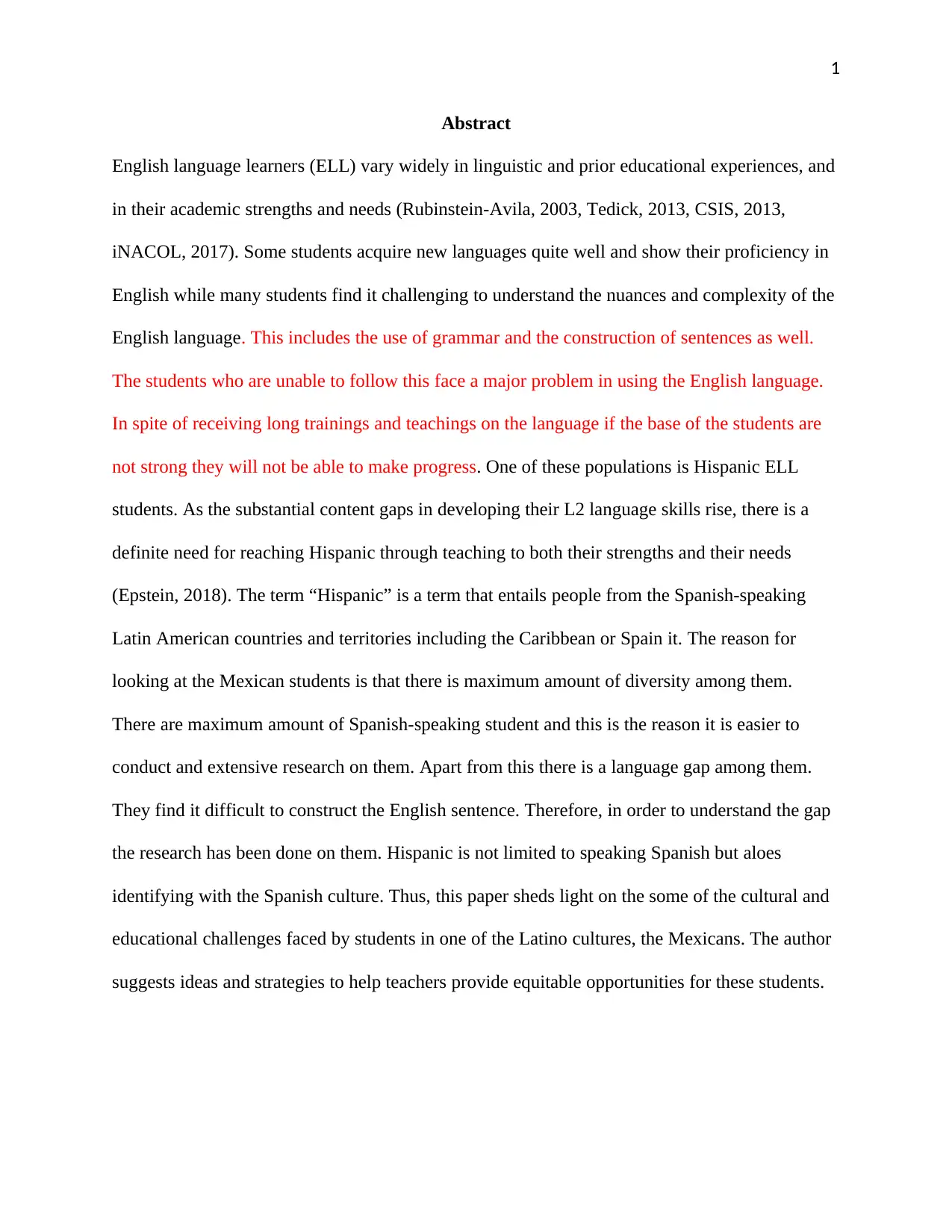
1
Abstract
English language learners (ELL) vary widely in linguistic and prior educational experiences, and
in their academic strengths and needs (Rubinstein-Avila, 2003, Tedick, 2013, CSIS, 2013,
iNACOL, 2017). Some students acquire new languages quite well and show their proficiency in
English while many students find it challenging to understand the nuances and complexity of the
English language. This includes the use of grammar and the construction of sentences as well.
The students who are unable to follow this face a major problem in using the English language.
In spite of receiving long trainings and teachings on the language if the base of the students are
not strong they will not be able to make progress. One of these populations is Hispanic ELL
students. As the substantial content gaps in developing their L2 language skills rise, there is a
definite need for reaching Hispanic through teaching to both their strengths and their needs
(Epstein, 2018). The term “Hispanic” is a term that entails people from the Spanish-speaking
Latin American countries and territories including the Caribbean or Spain it. The reason for
looking at the Mexican students is that there is maximum amount of diversity among them.
There are maximum amount of Spanish-speaking student and this is the reason it is easier to
conduct and extensive research on them. Apart from this there is a language gap among them.
They find it difficult to construct the English sentence. Therefore, in order to understand the gap
the research has been done on them. Hispanic is not limited to speaking Spanish but aloes
identifying with the Spanish culture. Thus, this paper sheds light on the some of the cultural and
educational challenges faced by students in one of the Latino cultures, the Mexicans. The author
suggests ideas and strategies to help teachers provide equitable opportunities for these students.
Abstract
English language learners (ELL) vary widely in linguistic and prior educational experiences, and
in their academic strengths and needs (Rubinstein-Avila, 2003, Tedick, 2013, CSIS, 2013,
iNACOL, 2017). Some students acquire new languages quite well and show their proficiency in
English while many students find it challenging to understand the nuances and complexity of the
English language. This includes the use of grammar and the construction of sentences as well.
The students who are unable to follow this face a major problem in using the English language.
In spite of receiving long trainings and teachings on the language if the base of the students are
not strong they will not be able to make progress. One of these populations is Hispanic ELL
students. As the substantial content gaps in developing their L2 language skills rise, there is a
definite need for reaching Hispanic through teaching to both their strengths and their needs
(Epstein, 2018). The term “Hispanic” is a term that entails people from the Spanish-speaking
Latin American countries and territories including the Caribbean or Spain it. The reason for
looking at the Mexican students is that there is maximum amount of diversity among them.
There are maximum amount of Spanish-speaking student and this is the reason it is easier to
conduct and extensive research on them. Apart from this there is a language gap among them.
They find it difficult to construct the English sentence. Therefore, in order to understand the gap
the research has been done on them. Hispanic is not limited to speaking Spanish but aloes
identifying with the Spanish culture. Thus, this paper sheds light on the some of the cultural and
educational challenges faced by students in one of the Latino cultures, the Mexicans. The author
suggests ideas and strategies to help teachers provide equitable opportunities for these students.
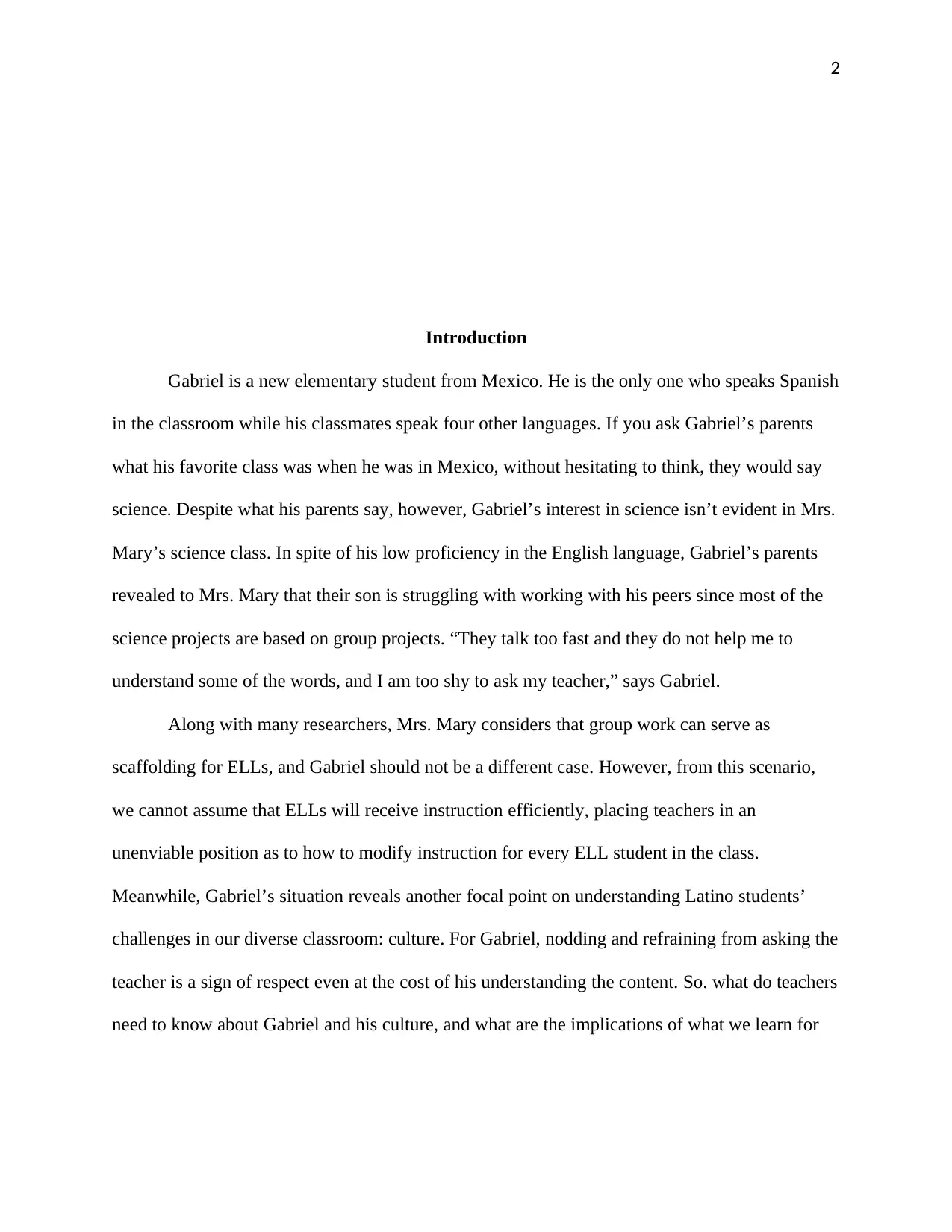
2
Introduction
Gabriel is a new elementary student from Mexico. He is the only one who speaks Spanish
in the classroom while his classmates speak four other languages. If you ask Gabriel’s parents
what his favorite class was when he was in Mexico, without hesitating to think, they would say
science. Despite what his parents say, however, Gabriel’s interest in science isn’t evident in Mrs.
Mary’s science class. In spite of his low proficiency in the English language, Gabriel’s parents
revealed to Mrs. Mary that their son is struggling with working with his peers since most of the
science projects are based on group projects. “They talk too fast and they do not help me to
understand some of the words, and I am too shy to ask my teacher,” says Gabriel.
Along with many researchers, Mrs. Mary considers that group work can serve as
scaffolding for ELLs, and Gabriel should not be a different case. However, from this scenario,
we cannot assume that ELLs will receive instruction efficiently, placing teachers in an
unenviable position as to how to modify instruction for every ELL student in the class.
Meanwhile, Gabriel’s situation reveals another focal point on understanding Latino students’
challenges in our diverse classroom: culture. For Gabriel, nodding and refraining from asking the
teacher is a sign of respect even at the cost of his understanding the content. So. what do teachers
need to know about Gabriel and his culture, and what are the implications of what we learn for
Introduction
Gabriel is a new elementary student from Mexico. He is the only one who speaks Spanish
in the classroom while his classmates speak four other languages. If you ask Gabriel’s parents
what his favorite class was when he was in Mexico, without hesitating to think, they would say
science. Despite what his parents say, however, Gabriel’s interest in science isn’t evident in Mrs.
Mary’s science class. In spite of his low proficiency in the English language, Gabriel’s parents
revealed to Mrs. Mary that their son is struggling with working with his peers since most of the
science projects are based on group projects. “They talk too fast and they do not help me to
understand some of the words, and I am too shy to ask my teacher,” says Gabriel.
Along with many researchers, Mrs. Mary considers that group work can serve as
scaffolding for ELLs, and Gabriel should not be a different case. However, from this scenario,
we cannot assume that ELLs will receive instruction efficiently, placing teachers in an
unenviable position as to how to modify instruction for every ELL student in the class.
Meanwhile, Gabriel’s situation reveals another focal point on understanding Latino students’
challenges in our diverse classroom: culture. For Gabriel, nodding and refraining from asking the
teacher is a sign of respect even at the cost of his understanding the content. So. what do teachers
need to know about Gabriel and his culture, and what are the implications of what we learn for
⊘ This is a preview!⊘
Do you want full access?
Subscribe today to unlock all pages.

Trusted by 1+ million students worldwide
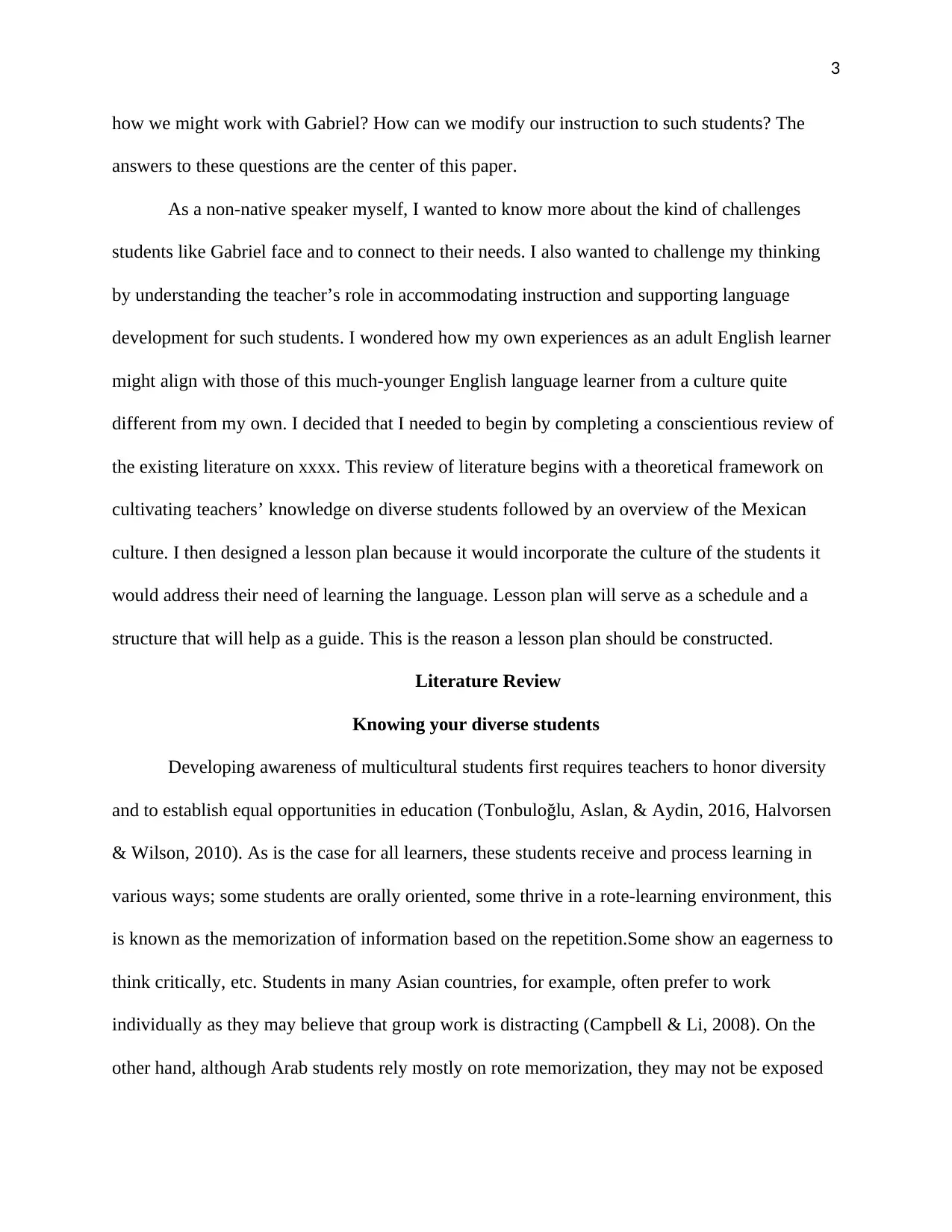
3
how we might work with Gabriel? How can we modify our instruction to such students? The
answers to these questions are the center of this paper.
As a non-native speaker myself, I wanted to know more about the kind of challenges
students like Gabriel face and to connect to their needs. I also wanted to challenge my thinking
by understanding the teacher’s role in accommodating instruction and supporting language
development for such students. I wondered how my own experiences as an adult English learner
might align with those of this much-younger English language learner from a culture quite
different from my own. I decided that I needed to begin by completing a conscientious review of
the existing literature on xxxx. This review of literature begins with a theoretical framework on
cultivating teachers’ knowledge on diverse students followed by an overview of the Mexican
culture. I then designed a lesson plan because it would incorporate the culture of the students it
would address their need of learning the language. Lesson plan will serve as a schedule and a
structure that will help as a guide. This is the reason a lesson plan should be constructed.
Literature Review
Knowing your diverse students
Developing awareness of multicultural students first requires teachers to honor diversity
and to establish equal opportunities in education (Tonbuloğlu, Aslan, & Aydin, 2016, Halvorsen
& Wilson, 2010). As is the case for all learners, these students receive and process learning in
various ways; some students are orally oriented, some thrive in a rote-learning environment, this
is known as the memorization of information based on the repetition.Some show an eagerness to
think critically, etc. Students in many Asian countries, for example, often prefer to work
individually as they may believe that group work is distracting (Campbell & Li, 2008). On the
other hand, although Arab students rely mostly on rote memorization, they may not be exposed
how we might work with Gabriel? How can we modify our instruction to such students? The
answers to these questions are the center of this paper.
As a non-native speaker myself, I wanted to know more about the kind of challenges
students like Gabriel face and to connect to their needs. I also wanted to challenge my thinking
by understanding the teacher’s role in accommodating instruction and supporting language
development for such students. I wondered how my own experiences as an adult English learner
might align with those of this much-younger English language learner from a culture quite
different from my own. I decided that I needed to begin by completing a conscientious review of
the existing literature on xxxx. This review of literature begins with a theoretical framework on
cultivating teachers’ knowledge on diverse students followed by an overview of the Mexican
culture. I then designed a lesson plan because it would incorporate the culture of the students it
would address their need of learning the language. Lesson plan will serve as a schedule and a
structure that will help as a guide. This is the reason a lesson plan should be constructed.
Literature Review
Knowing your diverse students
Developing awareness of multicultural students first requires teachers to honor diversity
and to establish equal opportunities in education (Tonbuloğlu, Aslan, & Aydin, 2016, Halvorsen
& Wilson, 2010). As is the case for all learners, these students receive and process learning in
various ways; some students are orally oriented, some thrive in a rote-learning environment, this
is known as the memorization of information based on the repetition.Some show an eagerness to
think critically, etc. Students in many Asian countries, for example, often prefer to work
individually as they may believe that group work is distracting (Campbell & Li, 2008). On the
other hand, although Arab students rely mostly on rote memorization, they may not be exposed
Paraphrase This Document
Need a fresh take? Get an instant paraphrase of this document with our AI Paraphraser
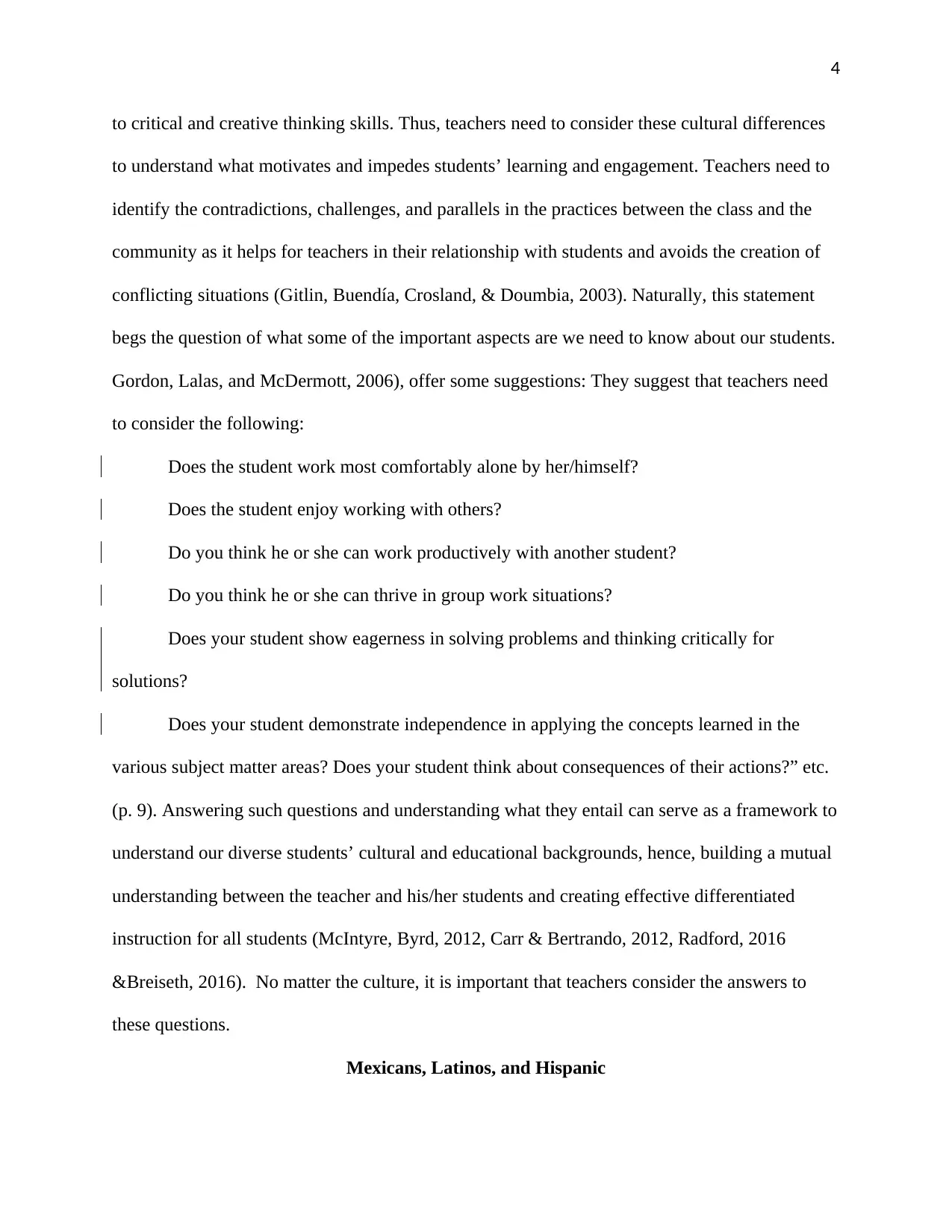
4
to critical and creative thinking skills. Thus, teachers need to consider these cultural differences
to understand what motivates and impedes students’ learning and engagement. Teachers need to
identify the contradictions, challenges, and parallels in the practices between the class and the
community as it helps for teachers in their relationship with students and avoids the creation of
conflicting situations (Gitlin, Buendía, Crosland, & Doumbia, 2003). Naturally, this statement
begs the question of what some of the important aspects are we need to know about our students.
Gordon, Lalas, and McDermott, 2006), offer some suggestions: They suggest that teachers need
to consider the following:
Does the student work most comfortably alone by her/himself?
Does the student enjoy working with others?
Do you think he or she can work productively with another student?
Do you think he or she can thrive in group work situations?
Does your student show eagerness in solving problems and thinking critically for
solutions?
Does your student demonstrate independence in applying the concepts learned in the
various subject matter areas? Does your student think about consequences of their actions?” etc.
(p. 9). Answering such questions and understanding what they entail can serve as a framework to
understand our diverse students’ cultural and educational backgrounds, hence, building a mutual
understanding between the teacher and his/her students and creating effective differentiated
instruction for all students (McIntyre, Byrd, 2012, Carr & Bertrando, 2012, Radford, 2016
&Breiseth, 2016). No matter the culture, it is important that teachers consider the answers to
these questions.
Mexicans, Latinos, and Hispanic
to critical and creative thinking skills. Thus, teachers need to consider these cultural differences
to understand what motivates and impedes students’ learning and engagement. Teachers need to
identify the contradictions, challenges, and parallels in the practices between the class and the
community as it helps for teachers in their relationship with students and avoids the creation of
conflicting situations (Gitlin, Buendía, Crosland, & Doumbia, 2003). Naturally, this statement
begs the question of what some of the important aspects are we need to know about our students.
Gordon, Lalas, and McDermott, 2006), offer some suggestions: They suggest that teachers need
to consider the following:
Does the student work most comfortably alone by her/himself?
Does the student enjoy working with others?
Do you think he or she can work productively with another student?
Do you think he or she can thrive in group work situations?
Does your student show eagerness in solving problems and thinking critically for
solutions?
Does your student demonstrate independence in applying the concepts learned in the
various subject matter areas? Does your student think about consequences of their actions?” etc.
(p. 9). Answering such questions and understanding what they entail can serve as a framework to
understand our diverse students’ cultural and educational backgrounds, hence, building a mutual
understanding between the teacher and his/her students and creating effective differentiated
instruction for all students (McIntyre, Byrd, 2012, Carr & Bertrando, 2012, Radford, 2016
&Breiseth, 2016). No matter the culture, it is important that teachers consider the answers to
these questions.
Mexicans, Latinos, and Hispanic

5
Before going further with this paper, it is first useful to clarify terms that are often used
interchangeably but incorrectly. The term “Latino” refers to someone who speaks any language
of Latin descent, the term “Mexican” is a nationality, and “Hispanic” is an old Spanish (as in
Spaniard) term to describe anyone from Spanish descent. Both "Hispanic" and "Latino" are used
to denote people living in America. They both are terms used to categorize many Latino groups.
Some people get offended by it or try to make a point they do not allow the government to put
them into a "box" so they refuse that term(Shin, 2017).
Mexican Values
There are unique characteristics of the Mexican cultural values in general. Some of the
core values include:
1) The group has extensive family memberships and strong family values. Such factors
contribute to the group’s collectivist mindset, where helping younger siblings and relatives, in
general, is part of the culture (Sáenz, Ponjuán, Figueroa, Serrata, 2016). Accordingly,
collaboration and cooperation are vital elements of the culture (Figueroa, Rodrigues, Hernandez
& Rosas, 2012).
2) The religiousness of the Mexican group is another characteristic cultural factor. Mexican
children are more inclined to adopt the religious beliefs of their parents (Changing Faiths:
Latinos and the Transformation of American Religion, 2007), and thus, contradicting values
might pose a conflict between culture at school and at home for the children. Regarding religious
affiliation, the majority of Mexicans and Americans of Mexican descent identify themselves as
Catholic with a small portion of Protestant. There is also very small percentage followers of
other religions such as Judaism, Buddhism and Islam (Changing Faiths: Latinos and the
Transformation of American Religion, 2007).
Before going further with this paper, it is first useful to clarify terms that are often used
interchangeably but incorrectly. The term “Latino” refers to someone who speaks any language
of Latin descent, the term “Mexican” is a nationality, and “Hispanic” is an old Spanish (as in
Spaniard) term to describe anyone from Spanish descent. Both "Hispanic" and "Latino" are used
to denote people living in America. They both are terms used to categorize many Latino groups.
Some people get offended by it or try to make a point they do not allow the government to put
them into a "box" so they refuse that term(Shin, 2017).
Mexican Values
There are unique characteristics of the Mexican cultural values in general. Some of the
core values include:
1) The group has extensive family memberships and strong family values. Such factors
contribute to the group’s collectivist mindset, where helping younger siblings and relatives, in
general, is part of the culture (Sáenz, Ponjuán, Figueroa, Serrata, 2016). Accordingly,
collaboration and cooperation are vital elements of the culture (Figueroa, Rodrigues, Hernandez
& Rosas, 2012).
2) The religiousness of the Mexican group is another characteristic cultural factor. Mexican
children are more inclined to adopt the religious beliefs of their parents (Changing Faiths:
Latinos and the Transformation of American Religion, 2007), and thus, contradicting values
might pose a conflict between culture at school and at home for the children. Regarding religious
affiliation, the majority of Mexicans and Americans of Mexican descent identify themselves as
Catholic with a small portion of Protestant. There is also very small percentage followers of
other religions such as Judaism, Buddhism and Islam (Changing Faiths: Latinos and the
Transformation of American Religion, 2007).
⊘ This is a preview!⊘
Do you want full access?
Subscribe today to unlock all pages.

Trusted by 1+ million students worldwide
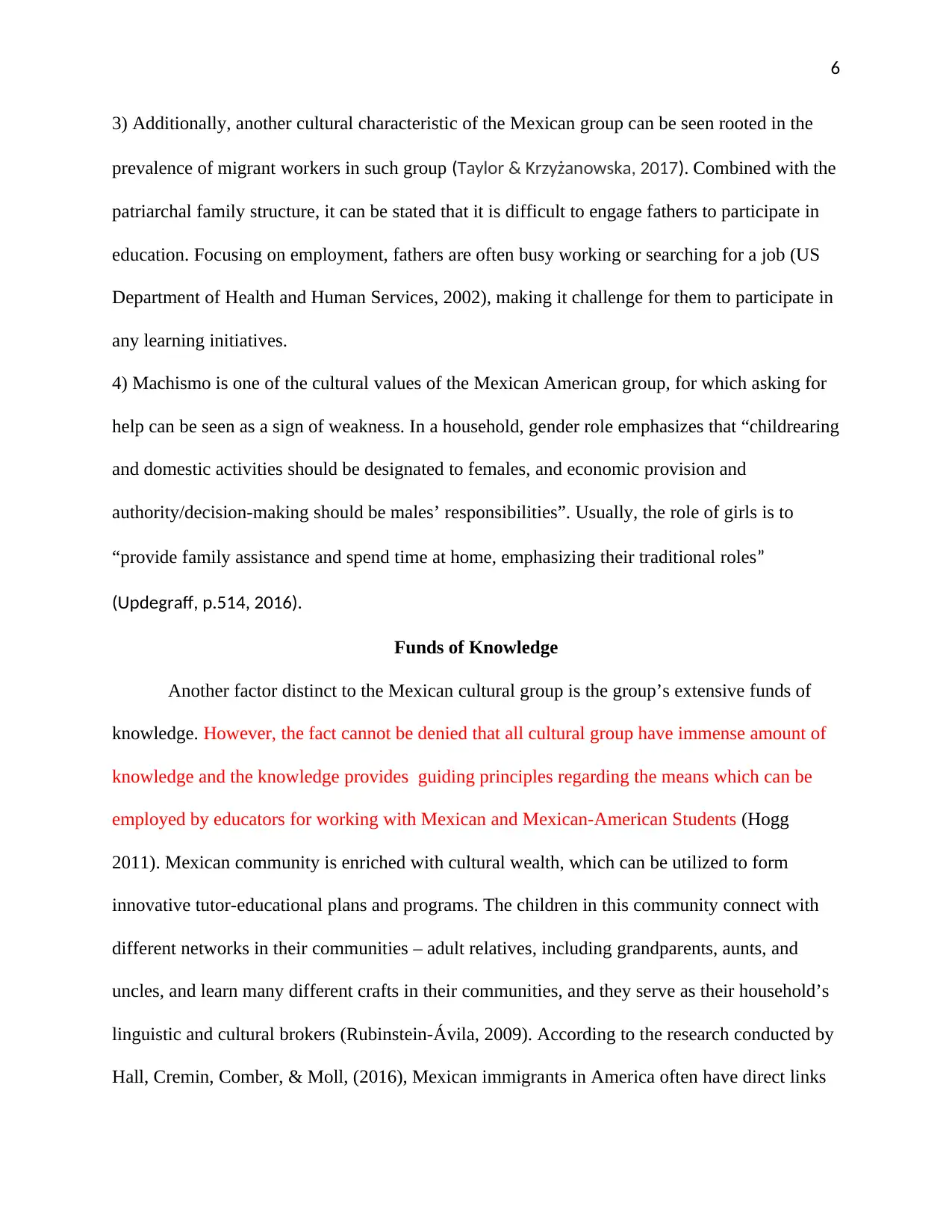
6
3) Additionally, another cultural characteristic of the Mexican group can be seen rooted in the
prevalence of migrant workers in such group (Taylor & Krzyżanowska, 2017). Combined with the
patriarchal family structure, it can be stated that it is difficult to engage fathers to participate in
education. Focusing on employment, fathers are often busy working or searching for a job (US
Department of Health and Human Services, 2002), making it challenge for them to participate in
any learning initiatives.
4) Machismo is one of the cultural values of the Mexican American group, for which asking for
help can be seen as a sign of weakness. In a household, gender role emphasizes that “childrearing
and domestic activities should be designated to females, and economic provision and
authority/decision-making should be males’ responsibilities”. Usually, the role of girls is to
“provide family assistance and spend time at home, emphasizing their traditional roles”
(Updegraff, p.514, 2016).
Funds of Knowledge
Another factor distinct to the Mexican cultural group is the group’s extensive funds of
knowledge. However, the fact cannot be denied that all cultural group have immense amount of
knowledge and the knowledge provides guiding principles regarding the means which can be
employed by educators for working with Mexican and Mexican-American Students (Hogg
2011). Mexican community is enriched with cultural wealth, which can be utilized to form
innovative tutor-educational plans and programs. The children in this community connect with
different networks in their communities – adult relatives, including grandparents, aunts, and
uncles, and learn many different crafts in their communities, and they serve as their household’s
linguistic and cultural brokers (Rubinstein-Ávila, 2009). According to the research conducted by
Hall, Cremin, Comber, & Moll, (2016), Mexican immigrants in America often have direct links
3) Additionally, another cultural characteristic of the Mexican group can be seen rooted in the
prevalence of migrant workers in such group (Taylor & Krzyżanowska, 2017). Combined with the
patriarchal family structure, it can be stated that it is difficult to engage fathers to participate in
education. Focusing on employment, fathers are often busy working or searching for a job (US
Department of Health and Human Services, 2002), making it challenge for them to participate in
any learning initiatives.
4) Machismo is one of the cultural values of the Mexican American group, for which asking for
help can be seen as a sign of weakness. In a household, gender role emphasizes that “childrearing
and domestic activities should be designated to females, and economic provision and
authority/decision-making should be males’ responsibilities”. Usually, the role of girls is to
“provide family assistance and spend time at home, emphasizing their traditional roles”
(Updegraff, p.514, 2016).
Funds of Knowledge
Another factor distinct to the Mexican cultural group is the group’s extensive funds of
knowledge. However, the fact cannot be denied that all cultural group have immense amount of
knowledge and the knowledge provides guiding principles regarding the means which can be
employed by educators for working with Mexican and Mexican-American Students (Hogg
2011). Mexican community is enriched with cultural wealth, which can be utilized to form
innovative tutor-educational plans and programs. The children in this community connect with
different networks in their communities – adult relatives, including grandparents, aunts, and
uncles, and learn many different crafts in their communities, and they serve as their household’s
linguistic and cultural brokers (Rubinstein-Ávila, 2009). According to the research conducted by
Hall, Cremin, Comber, & Moll, (2016), Mexican immigrants in America often have direct links
Paraphrase This Document
Need a fresh take? Get an instant paraphrase of this document with our AI Paraphraser

7
with their relatives in Mexico. The education and the culture of having wealth is predominant in
the regions of Arizona, mostly found in the Mexican households of Sonora.
According to Moll, Soto-Santiago&Schwartz, (2013), Mexican households engage in
activities in order to restore, re-invent and reproduce their identities. Additionally, a sense of
belonging and dignity is associated with their funds of knowledge. There are various factors that
are involved to have a good livelihood. The focus should always lay on the way to make a good
living but it also depends on other cultural and aesthetic activities that is prevalent in the Mexico
city.The social and political context has also shaped and influenced Mexican households, and
their vulnerabilities and activities, too. Hence, it is necessary to re-assess the grounds on which
these entities are influenced.
According to Saathoff, (2015), the members of the Mexican community had to master
skills and knowledge when they migrate to America and other countries. This change was
necessary to learn about their heritage when leaving their home and for teaching the new
generation, until date, there are members of the community who are extremely experienced and
are known as generalist which hold complex knowledge.
In a study of XXX by Lincona, (2013), Mexican students often have been viewed through
the “deficit lens” which reduces their importance and subjects them to lower expectations. This
can be stated because it has been observed that those students have suffered from the gap. This is
characterized by the expectation of lower grades and a low academic performance. This belief is
rejected by many (Lincona, 2013), and it is demonstrated through research that the Mexican
community has an array of relevant knowledge which helps them to moderate through their daily
lives.
with their relatives in Mexico. The education and the culture of having wealth is predominant in
the regions of Arizona, mostly found in the Mexican households of Sonora.
According to Moll, Soto-Santiago&Schwartz, (2013), Mexican households engage in
activities in order to restore, re-invent and reproduce their identities. Additionally, a sense of
belonging and dignity is associated with their funds of knowledge. There are various factors that
are involved to have a good livelihood. The focus should always lay on the way to make a good
living but it also depends on other cultural and aesthetic activities that is prevalent in the Mexico
city.The social and political context has also shaped and influenced Mexican households, and
their vulnerabilities and activities, too. Hence, it is necessary to re-assess the grounds on which
these entities are influenced.
According to Saathoff, (2015), the members of the Mexican community had to master
skills and knowledge when they migrate to America and other countries. This change was
necessary to learn about their heritage when leaving their home and for teaching the new
generation, until date, there are members of the community who are extremely experienced and
are known as generalist which hold complex knowledge.
In a study of XXX by Lincona, (2013), Mexican students often have been viewed through
the “deficit lens” which reduces their importance and subjects them to lower expectations. This
can be stated because it has been observed that those students have suffered from the gap. This is
characterized by the expectation of lower grades and a low academic performance. This belief is
rejected by many (Lincona, 2013), and it is demonstrated through research that the Mexican
community has an array of relevant knowledge which helps them to moderate through their daily
lives.
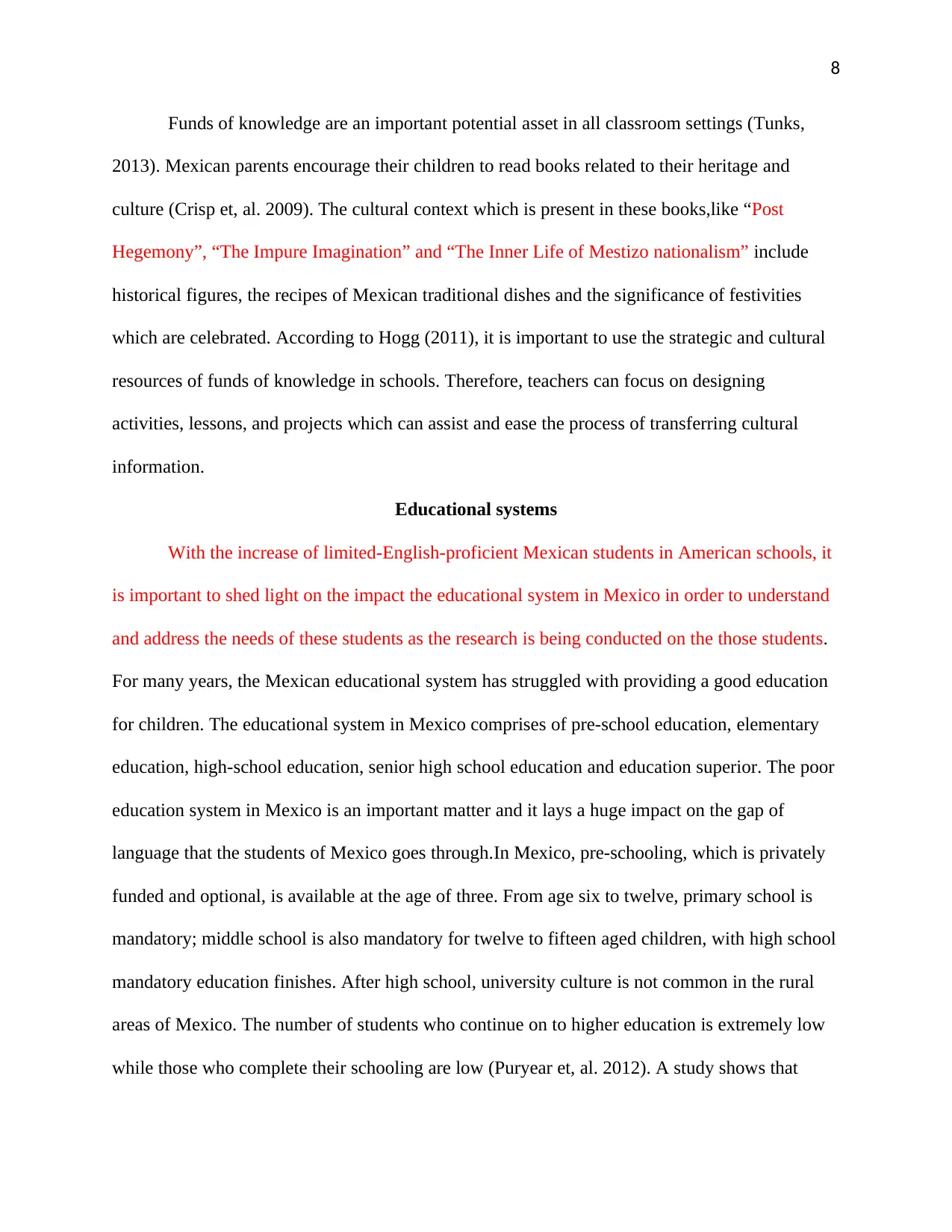
8
Funds of knowledge are an important potential asset in all classroom settings (Tunks,
2013). Mexican parents encourage their children to read books related to their heritage and
culture (Crisp et, al. 2009). The cultural context which is present in these books,like “Post
Hegemony”, “The Impure Imagination” and “The Inner Life of Mestizo nationalism” include
historical figures, the recipes of Mexican traditional dishes and the significance of festivities
which are celebrated. According to Hogg (2011), it is important to use the strategic and cultural
resources of funds of knowledge in schools. Therefore, teachers can focus on designing
activities, lessons, and projects which can assist and ease the process of transferring cultural
information.
Educational systems
With the increase of limited-English-proficient Mexican students in American schools, it
is important to shed light on the impact the educational system in Mexico in order to understand
and address the needs of these students as the research is being conducted on the those students.
For many years, the Mexican educational system has struggled with providing a good education
for children. The educational system in Mexico comprises of pre-school education, elementary
education, high-school education, senior high school education and education superior. The poor
education system in Mexico is an important matter and it lays a huge impact on the gap of
language that the students of Mexico goes through.In Mexico, pre-schooling, which is privately
funded and optional, is available at the age of three. From age six to twelve, primary school is
mandatory; middle school is also mandatory for twelve to fifteen aged children, with high school
mandatory education finishes. After high school, university culture is not common in the rural
areas of Mexico. The number of students who continue on to higher education is extremely low
while those who complete their schooling are low (Puryear et, al. 2012). A study shows that
Funds of knowledge are an important potential asset in all classroom settings (Tunks,
2013). Mexican parents encourage their children to read books related to their heritage and
culture (Crisp et, al. 2009). The cultural context which is present in these books,like “Post
Hegemony”, “The Impure Imagination” and “The Inner Life of Mestizo nationalism” include
historical figures, the recipes of Mexican traditional dishes and the significance of festivities
which are celebrated. According to Hogg (2011), it is important to use the strategic and cultural
resources of funds of knowledge in schools. Therefore, teachers can focus on designing
activities, lessons, and projects which can assist and ease the process of transferring cultural
information.
Educational systems
With the increase of limited-English-proficient Mexican students in American schools, it
is important to shed light on the impact the educational system in Mexico in order to understand
and address the needs of these students as the research is being conducted on the those students.
For many years, the Mexican educational system has struggled with providing a good education
for children. The educational system in Mexico comprises of pre-school education, elementary
education, high-school education, senior high school education and education superior. The poor
education system in Mexico is an important matter and it lays a huge impact on the gap of
language that the students of Mexico goes through.In Mexico, pre-schooling, which is privately
funded and optional, is available at the age of three. From age six to twelve, primary school is
mandatory; middle school is also mandatory for twelve to fifteen aged children, with high school
mandatory education finishes. After high school, university culture is not common in the rural
areas of Mexico. The number of students who continue on to higher education is extremely low
while those who complete their schooling are low (Puryear et, al. 2012). A study shows that
⊘ This is a preview!⊘
Do you want full access?
Subscribe today to unlock all pages.

Trusted by 1+ million students worldwide
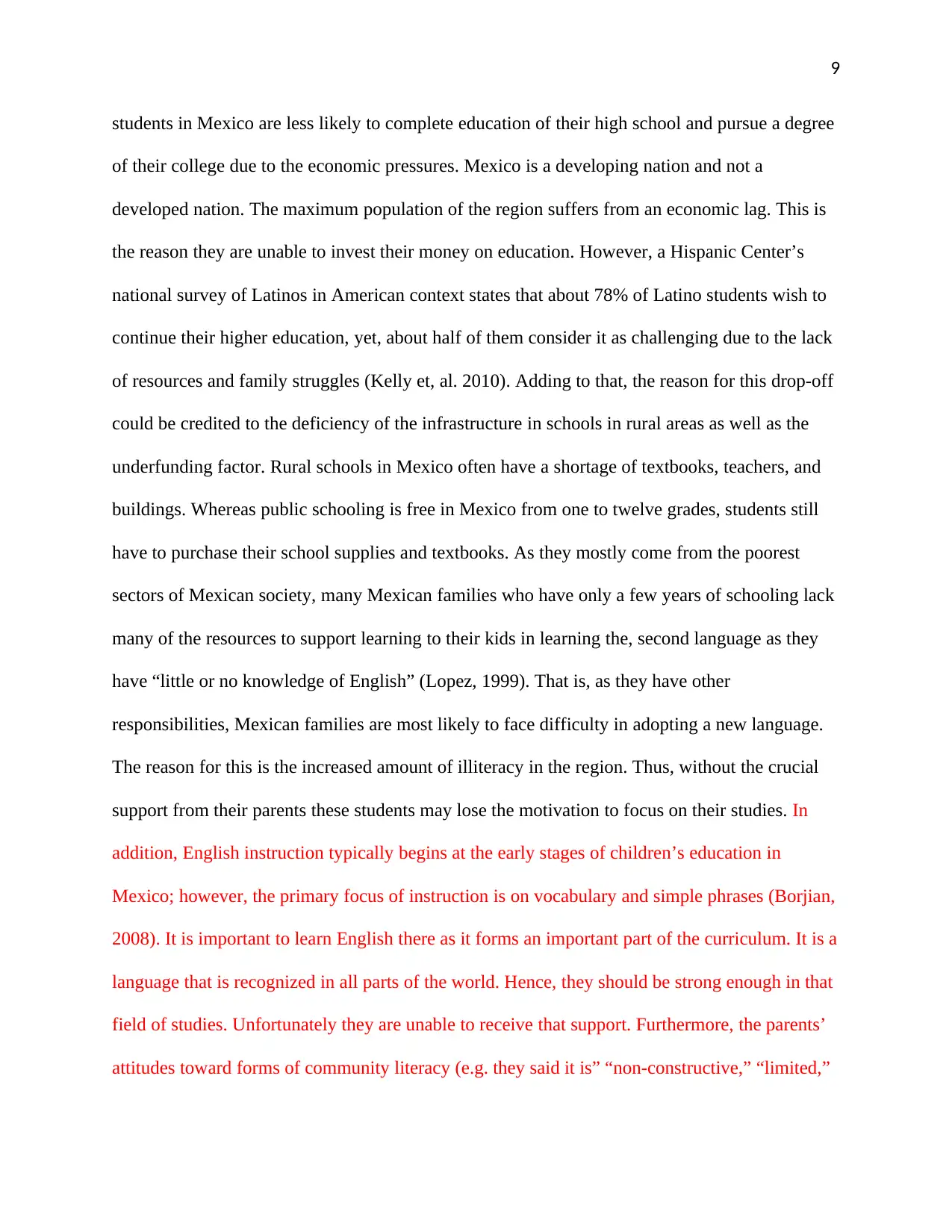
9
students in Mexico are less likely to complete education of their high school and pursue a degree
of their college due to the economic pressures. Mexico is a developing nation and not a
developed nation. The maximum population of the region suffers from an economic lag. This is
the reason they are unable to invest their money on education. However, a Hispanic Center’s
national survey of Latinos in American context states that about 78% of Latino students wish to
continue their higher education, yet, about half of them consider it as challenging due to the lack
of resources and family struggles (Kelly et, al. 2010). Adding to that, the reason for this drop-off
could be credited to the deficiency of the infrastructure in schools in rural areas as well as the
underfunding factor. Rural schools in Mexico often have a shortage of textbooks, teachers, and
buildings. Whereas public schooling is free in Mexico from one to twelve grades, students still
have to purchase their school supplies and textbooks. As they mostly come from the poorest
sectors of Mexican society, many Mexican families who have only a few years of schooling lack
many of the resources to support learning to their kids in learning the, second language as they
have “little or no knowledge of English” (Lopez, 1999). That is, as they have other
responsibilities, Mexican families are most likely to face difficulty in adopting a new language.
The reason for this is the increased amount of illiteracy in the region. Thus, without the crucial
support from their parents these students may lose the motivation to focus on their studies. In
addition, English instruction typically begins at the early stages of children’s education in
Mexico; however, the primary focus of instruction is on vocabulary and simple phrases (Borjian,
2008). It is important to learn English there as it forms an important part of the curriculum. It is a
language that is recognized in all parts of the world. Hence, they should be strong enough in that
field of studies. Unfortunately they are unable to receive that support. Furthermore, the parents’
attitudes toward forms of community literacy (e.g. they said it is” “non-constructive,” “limited,”
students in Mexico are less likely to complete education of their high school and pursue a degree
of their college due to the economic pressures. Mexico is a developing nation and not a
developed nation. The maximum population of the region suffers from an economic lag. This is
the reason they are unable to invest their money on education. However, a Hispanic Center’s
national survey of Latinos in American context states that about 78% of Latino students wish to
continue their higher education, yet, about half of them consider it as challenging due to the lack
of resources and family struggles (Kelly et, al. 2010). Adding to that, the reason for this drop-off
could be credited to the deficiency of the infrastructure in schools in rural areas as well as the
underfunding factor. Rural schools in Mexico often have a shortage of textbooks, teachers, and
buildings. Whereas public schooling is free in Mexico from one to twelve grades, students still
have to purchase their school supplies and textbooks. As they mostly come from the poorest
sectors of Mexican society, many Mexican families who have only a few years of schooling lack
many of the resources to support learning to their kids in learning the, second language as they
have “little or no knowledge of English” (Lopez, 1999). That is, as they have other
responsibilities, Mexican families are most likely to face difficulty in adopting a new language.
The reason for this is the increased amount of illiteracy in the region. Thus, without the crucial
support from their parents these students may lose the motivation to focus on their studies. In
addition, English instruction typically begins at the early stages of children’s education in
Mexico; however, the primary focus of instruction is on vocabulary and simple phrases (Borjian,
2008). It is important to learn English there as it forms an important part of the curriculum. It is a
language that is recognized in all parts of the world. Hence, they should be strong enough in that
field of studies. Unfortunately they are unable to receive that support. Furthermore, the parents’
attitudes toward forms of community literacy (e.g. they said it is” “non-constructive,” “limited,”
Paraphrase This Document
Need a fresh take? Get an instant paraphrase of this document with our AI Paraphraser
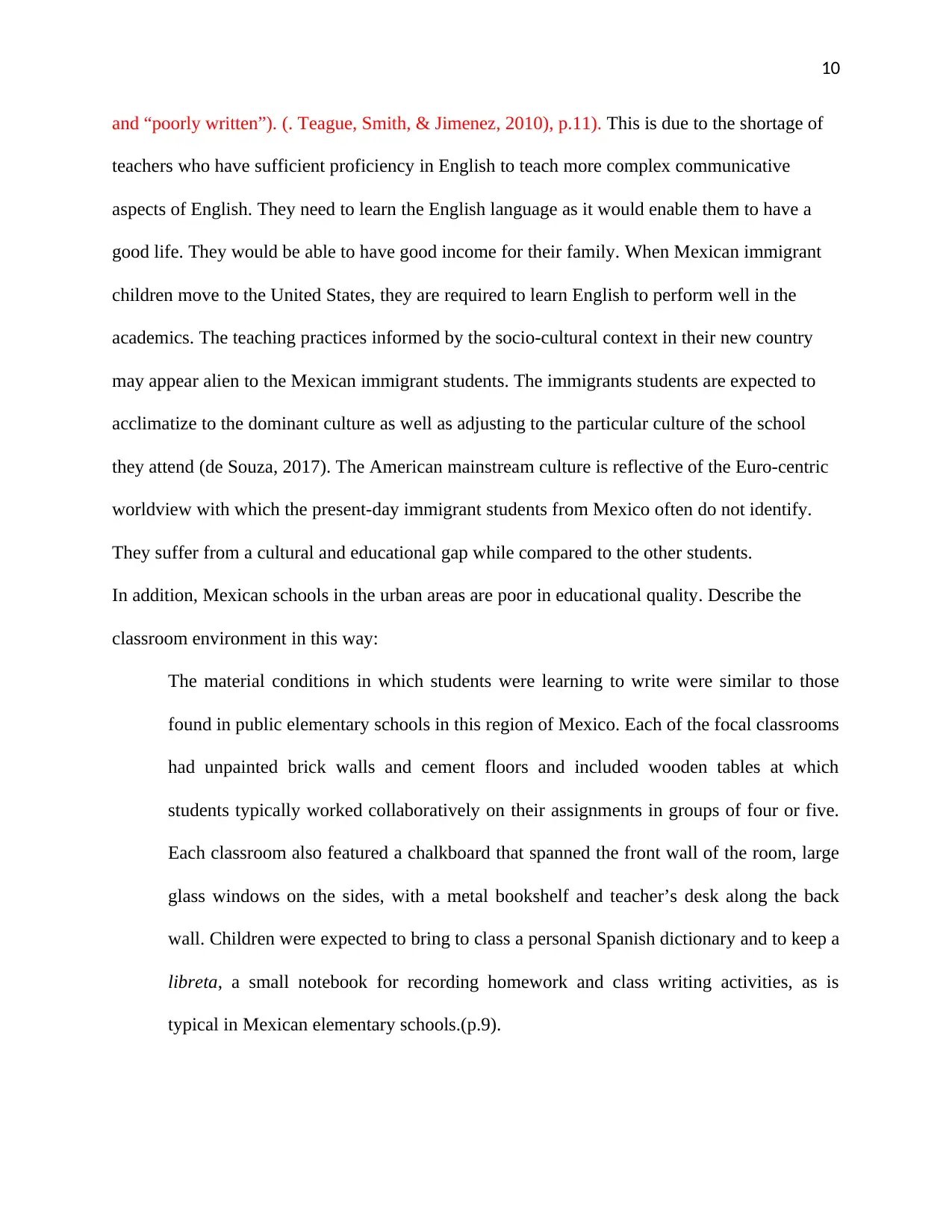
10
and “poorly written”). (. Teague, Smith, & Jimenez, 2010), p.11). This is due to the shortage of
teachers who have sufficient proficiency in English to teach more complex communicative
aspects of English. They need to learn the English language as it would enable them to have a
good life. They would be able to have good income for their family. When Mexican immigrant
children move to the United States, they are required to learn English to perform well in the
academics. The teaching practices informed by the socio-cultural context in their new country
may appear alien to the Mexican immigrant students. The immigrants students are expected to
acclimatize to the dominant culture as well as adjusting to the particular culture of the school
they attend (de Souza, 2017). The American mainstream culture is reflective of the Euro-centric
worldview with which the present-day immigrant students from Mexico often do not identify.
They suffer from a cultural and educational gap while compared to the other students.
In addition, Mexican schools in the urban areas are poor in educational quality. Describe the
classroom environment in this way:
The material conditions in which students were learning to write were similar to those
found in public elementary schools in this region of Mexico. Each of the focal classrooms
had unpainted brick walls and cement floors and included wooden tables at which
students typically worked collaboratively on their assignments in groups of four or five.
Each classroom also featured a chalkboard that spanned the front wall of the room, large
glass windows on the sides, with a metal bookshelf and teacher’s desk along the back
wall. Children were expected to bring to class a personal Spanish dictionary and to keep a
libreta, a small notebook for recording homework and class writing activities, as is
typical in Mexican elementary schools.(p.9).
and “poorly written”). (. Teague, Smith, & Jimenez, 2010), p.11). This is due to the shortage of
teachers who have sufficient proficiency in English to teach more complex communicative
aspects of English. They need to learn the English language as it would enable them to have a
good life. They would be able to have good income for their family. When Mexican immigrant
children move to the United States, they are required to learn English to perform well in the
academics. The teaching practices informed by the socio-cultural context in their new country
may appear alien to the Mexican immigrant students. The immigrants students are expected to
acclimatize to the dominant culture as well as adjusting to the particular culture of the school
they attend (de Souza, 2017). The American mainstream culture is reflective of the Euro-centric
worldview with which the present-day immigrant students from Mexico often do not identify.
They suffer from a cultural and educational gap while compared to the other students.
In addition, Mexican schools in the urban areas are poor in educational quality. Describe the
classroom environment in this way:
The material conditions in which students were learning to write were similar to those
found in public elementary schools in this region of Mexico. Each of the focal classrooms
had unpainted brick walls and cement floors and included wooden tables at which
students typically worked collaboratively on their assignments in groups of four or five.
Each classroom also featured a chalkboard that spanned the front wall of the room, large
glass windows on the sides, with a metal bookshelf and teacher’s desk along the back
wall. Children were expected to bring to class a personal Spanish dictionary and to keep a
libreta, a small notebook for recording homework and class writing activities, as is
typical in Mexican elementary schools.(p.9).
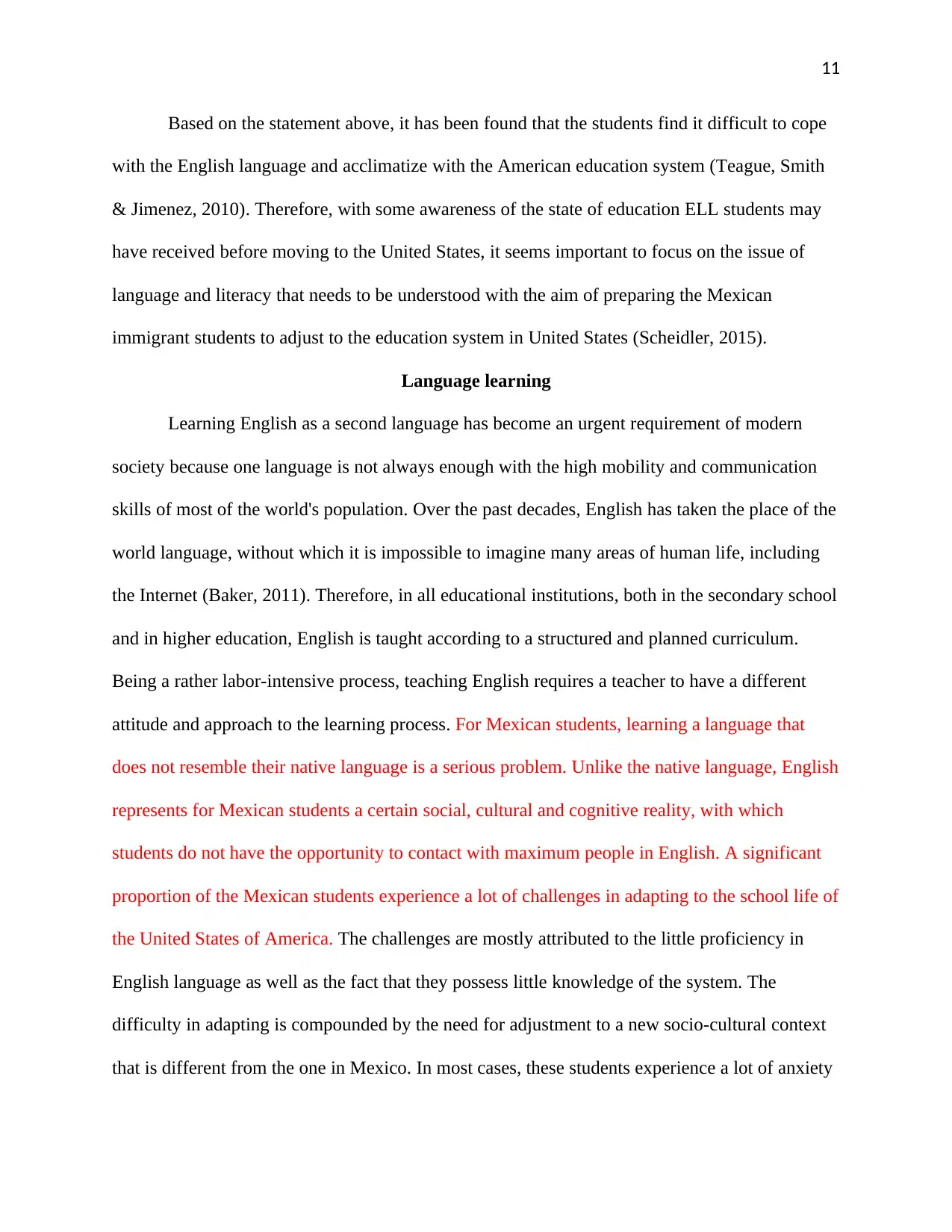
11
Based on the statement above, it has been found that the students find it difficult to cope
with the English language and acclimatize with the American education system (Teague, Smith
& Jimenez, 2010). Therefore, with some awareness of the state of education ELL students may
have received before moving to the United States, it seems important to focus on the issue of
language and literacy that needs to be understood with the aim of preparing the Mexican
immigrant students to adjust to the education system in United States (Scheidler, 2015).
Language learning
Learning English as a second language has become an urgent requirement of modern
society because one language is not always enough with the high mobility and communication
skills of most of the world's population. Over the past decades, English has taken the place of the
world language, without which it is impossible to imagine many areas of human life, including
the Internet (Baker, 2011). Therefore, in all educational institutions, both in the secondary school
and in higher education, English is taught according to a structured and planned curriculum.
Being a rather labor-intensive process, teaching English requires a teacher to have a different
attitude and approach to the learning process. For Mexican students, learning a language that
does not resemble their native language is a serious problem. Unlike the native language, English
represents for Mexican students a certain social, cultural and cognitive reality, with which
students do not have the opportunity to contact with maximum people in English. A significant
proportion of the Mexican students experience a lot of challenges in adapting to the school life of
the United States of America. The challenges are mostly attributed to the little proficiency in
English language as well as the fact that they possess little knowledge of the system. The
difficulty in adapting is compounded by the need for adjustment to a new socio-cultural context
that is different from the one in Mexico. In most cases, these students experience a lot of anxiety
Based on the statement above, it has been found that the students find it difficult to cope
with the English language and acclimatize with the American education system (Teague, Smith
& Jimenez, 2010). Therefore, with some awareness of the state of education ELL students may
have received before moving to the United States, it seems important to focus on the issue of
language and literacy that needs to be understood with the aim of preparing the Mexican
immigrant students to adjust to the education system in United States (Scheidler, 2015).
Language learning
Learning English as a second language has become an urgent requirement of modern
society because one language is not always enough with the high mobility and communication
skills of most of the world's population. Over the past decades, English has taken the place of the
world language, without which it is impossible to imagine many areas of human life, including
the Internet (Baker, 2011). Therefore, in all educational institutions, both in the secondary school
and in higher education, English is taught according to a structured and planned curriculum.
Being a rather labor-intensive process, teaching English requires a teacher to have a different
attitude and approach to the learning process. For Mexican students, learning a language that
does not resemble their native language is a serious problem. Unlike the native language, English
represents for Mexican students a certain social, cultural and cognitive reality, with which
students do not have the opportunity to contact with maximum people in English. A significant
proportion of the Mexican students experience a lot of challenges in adapting to the school life of
the United States of America. The challenges are mostly attributed to the little proficiency in
English language as well as the fact that they possess little knowledge of the system. The
difficulty in adapting is compounded by the need for adjustment to a new socio-cultural context
that is different from the one in Mexico. In most cases, these students experience a lot of anxiety
⊘ This is a preview!⊘
Do you want full access?
Subscribe today to unlock all pages.

Trusted by 1+ million students worldwide
1 out of 26
Your All-in-One AI-Powered Toolkit for Academic Success.
+13062052269
info@desklib.com
Available 24*7 on WhatsApp / Email
![[object Object]](/_next/static/media/star-bottom.7253800d.svg)
Unlock your academic potential
Copyright © 2020–2025 A2Z Services. All Rights Reserved. Developed and managed by ZUCOL.
